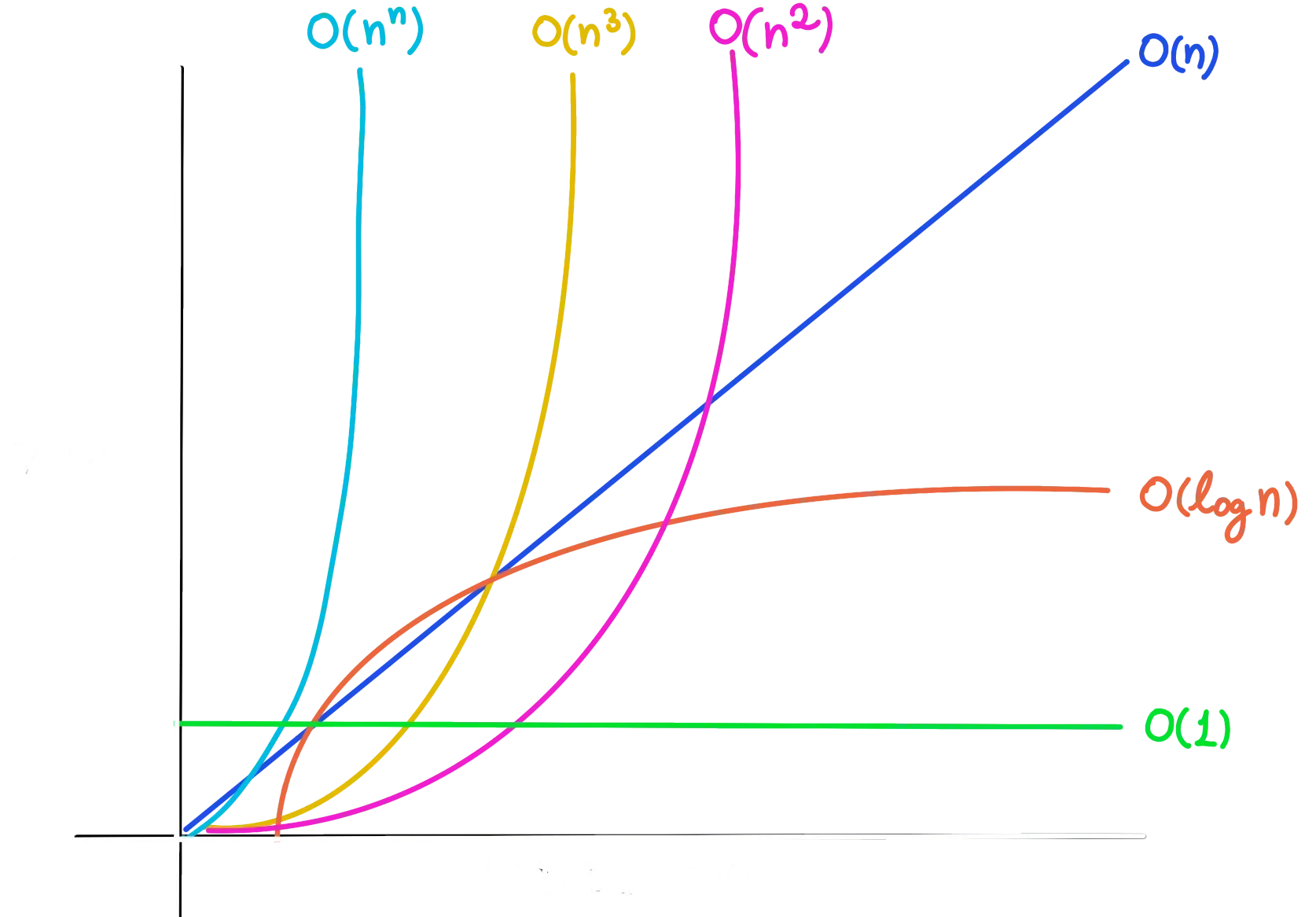Big O Notation
The speed and memory usage of an algorithm aren’t necessarily fixed; they might change depending on the input. So how do we express the performance of an algorithm then?
Enter Big O Notation, a powerful tool that allows us to generalize the space-time complexity of an algorithm as a function of its input size.
Let’s say we have an array of n length
$$ a = […] $$
And the following functions
$$ f_1(a) = 1 + a[0] $$
Simply returns the first element of array plus one
$$ f_2(a) = sum(a) $$
Return the sum of all elements in array
$$ f_3(a) = pair(a) $$
Each possible pair combination
All of those algorithms take an array.
const sum = arr => arr.reduce((acc, el) => acc + el, 0)
const pair = arr =>
arr.map(mainEl => arr.map(secondEl => [mainEl, secondEl]))
const arrayWithLengh = length => Array.from({length}, (v, k) => k+1)
const a = arrayWithLengh(10)
const a100Elements = arrayWithLengh(100)
const a1000Elements = arrayWithLengh(1000)
const f1 = (x) => 1 + x[0]
const f2 = (x) => sum(x)
const f3 = (x) => pair(x)
// Computed time For 1 Element
f1(a) // ~0.021ms (for 1 element)
f2(a) // ~0.046ms (for 1 element)
f3(a) // ~0.065ms (for 1 element)
// Computed time For 10 Elements
f1(a) // ~0.027ms (for 10 elements)
f2(a) // ~0.059ms (for 10 elements)
f3(a) // ~0.116ms (for 10 elements)
// Computed time For 100 Elements
f1(a100Elements) // ~0.021ms (for 100 elements)
f2(a100Elements) // ~0.071ms (for 100 elements)
f3(a100Elements) // ~3.644ms (for 100 elements)
// Computed time For 1000 Elements
f1(a1000Elements) // ~0.020ms (for 1000 elements)
f2(a1000Elements) // ~0.263ms (for 1000 elements)
f3(a1000Elements) // ~96.810ms (for 1000 elements)You can see that the speed of each algorithm is directly related to the length of the array. Big O notation help us understand and compare the complexity of each algorithm.
$$ f_1(a) = 1 + a[0] $$
Time Complexity: **O(1)**
**Constant**$$ f_2(a) = sum(a) $$
Time Complexity: **O(N)**
**Linear**$$ f_3(a) = pair(a) $$
Time Complexity: O(N²)
**Quadratic**Asymptotic Analyses
An example of What is Asymptotic Analyses? is a function f4 that contains all other functions
$$ f_4(a)= f_1(a) + f_2(a) + f_3(a) $$
This means that f4 have the complexity of
$$ O(1) + O(n) + O(n^2) ∴ O(n^2 + n + 1) $$
But notice how n and 1 is irrelevant when compared with n², so in this case we just say O(n²)
Most Used Notations

$$ O(1) \ \scriptsize \color{gray}Constant $$
$$ O(log\space n) \ \scriptsize \color{gray} Logaritimic $$
$$ O(n) \ \scriptsize \color{gray} Linear $$
$$ O(n * log\space n) \ \scriptsize \color{gray} Linearithimic $$
$$ O(n^2), O(n^3), O(n^4) \ \scriptsize \color{gray} Quadratic, Cubic, Polynomial $$
$$ O(2^n) \ \scriptsize \color{gray} Exponential $$
$$ O(n!) \ \scriptsize \color{gray} Factorial $$
🔥 Big O Notation always refer to the worst case scenario
Few Examples
O(25) → O(1)
O(2n) → O(n)
O(n² + 2n) → O(n²)
O(n³ + log(n) + 3) → O(n³)
O(n + m) → O(n + m)
O(2n + m) → O(n + m)
The most common Big O Notations are:
O(1) → Constant | Accessing a memory address
O(log n) → Logarithmic | Binary Search
O(n) → Linear | Iterating an Array
O(n log n) → Linearithimic | Iterating an Array
O(n²) → Quadratic | Nested Iterations
O(2^n) → Exponential | Nested Iterations
O(n!) → Factorial | Generate all permutations of a list
Time Complexity
A measure of how fast an algorithm runs, time complexity is a central concept in the field of algorithms. It’s expressed by using Big O notation.
Space Complexity
A measure of how much auxiliary memory an algorithm takes up, space complexity is a central concept in the field of algorithms and it’s also expressed using Big O notation
Flash Cards